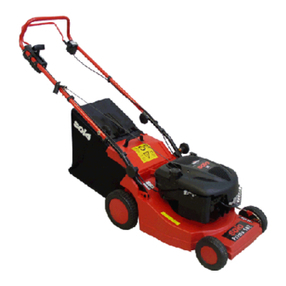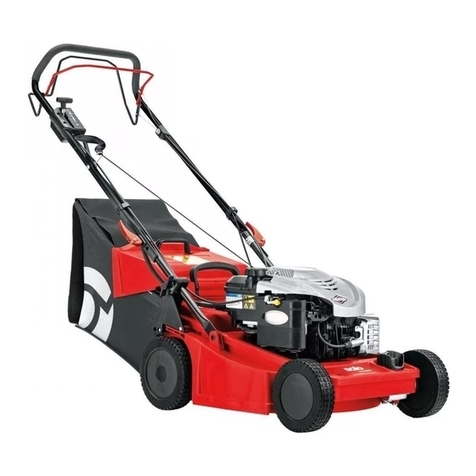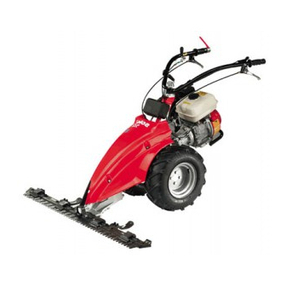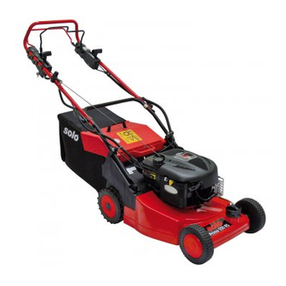4
•Beim Mähen an Böschungen und Hängen ist besondere Vorsicht geboten (z.B. beim Mähen entlang der Schräglinie,
ist das Tragen von Schuhen mit rutschfester Sohle notwendig.)
•Vor einem eventuellen Messerwechseln stets Handschuhe anlegen
•Sollte der Mäher durch Auffahren auf ein Hindernis einen Stoß erlitten haben, ist eine fachgemäße Überprüfung
erforderlich.
•Halten Sie Hände und Füße vom laufenden Schneidwerkzeug fern.
•Motor nicht in einem geschlossenen Raum laufen lassen, wo sich die Abgase, die Kohlenmonoxid enthalten,
ansammeln können.
•Benutzen Sie immer komplettes Zubehör, das mit der Sicherheitsvorrichtung versehen ist.
•Für die Reinigung, den Zusammenbau, die Demontage muss der Motor immer abgestellt werden.
•WICHTIG: Mähen Sie nicht an Hängen mit mehr als 30% Neigung.
•Für Unfälle die aus der Nichtbeachtung dieser Gebrauchsanweisung entstehen, können wir nicht haftbar gemacht
werden.
STARTEN UND ABSTELLEN DES BALKENMÄHERS
-Abb. Nr.5-
Vor jedem Starten ist folgendes zu kontrollieren:
•Ob das Gerät aufgetankt ist
•Ölstand: Das Motorenöl bis zum Niveau des Ölmessstabes einfüllen und regelmäßig
kontrollieren.
•Dass alle Sicherheitsfunktionen richtig arbeiten.
•Bei kaltem Motor drücken Sie dreimal die Primerpumpe (Abbildung 1, Nr. 9), bevor
Sie den Motor starten (siehe auch Motoren-Gebrauchsanweisung).
•Starten Sie die Maschine immer im Freien, in seitlicher Stellung.
•Der Handgashebel muss auf "START" gestellt sein. Dann fassen Sie den
Starterhandgriff mit einer Hand (Abbildung 5), ziehen leicht bis ein Widerstand zu
spüren ist, dann kräftig ziehen. Nachdem der Motor läuft, lassen Sie das Starterseil
nicht einfach zurückschnellen, sondern führen Sie es von Hand ins Gehäuse zurück,
bis es ganz aufgerollt ist.
•Für ein richtiges Starten des Motors lesen Sie den Abschnitt "Starten" im Gebrauchs- und Wartungshandbuch Motor
durch.
•Wenn der Motor läuft, muss der Handgashebel auf mittlere Position zurückgestellt werden (Abbildung 5)
•Zum Vorschub der Maschine den Kupplungshebel drücken (Abb.7, Pos.B), beim Loslassen des Hebels hält die
Maschine an.
•Der Balkenmäher kann bei gelöstem Kupplungshebel frei vor - oder zurückgeschoben werden. (Leerlauf)
SICHERHEITSHEBEL
Die Hauptfunktion dieses Hebels besteht darin, den Motor auszuschalten, wenn die Griffe von dem Führungsholm
weggenommen werden. Vor dem Arbeitsbeginn sicherstellen, dass das Ein- und Ausrücken des Antriebs an Rädern und
Balken mit den Hebeln an den Holmen korrekt erfolgt.
-Abb. Nr.6- -Abb. Nr.7-



















































